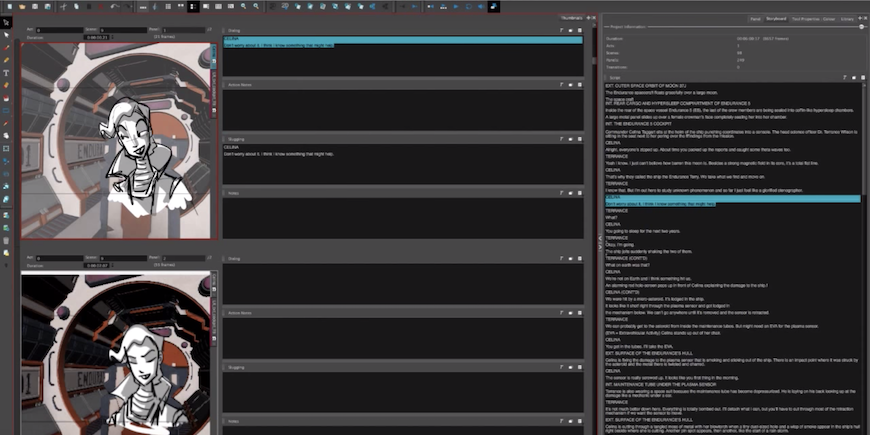

It’s structured in such a way that allows for quick access to all its tools. The work environment is highly intuitive and offers a wide range of drawing tools and well thought out features that can help you create not just a simple storyboard, but an animated script with both animations and audio soundtrack. Besides allowing you to create sketches, it also provides built-in animatics, camera motion and the ability to export your work to formats supported by other graphic editors. While it sounds like a tool drawing, it’s much more than that. Particularly when you want a wide variety in colour and shading, this is where you will see the real advantage.Toon Boom Storyboard Pro 3D is an application especially created to offer you the means to create a storyboard for your productions. Recommended Use: When creating drawings with a lot of texture, for a natural media feel. Also, it can be difficult to reuse the drawing at multiple distances.

Simply draw and erase, like you would on paper.
#TOON BOOM STORYBOARD PRO 5.5 DOWNLOAD FULL#
Also, you have full artistic control over the style of the drawing.ĭisadvantage: You cannot modify the lines after you draw them.
Īdvantage: File sizes are not as heavy as when you use textured brushes on a vector layer, since each stroke does not have to be remembered individually. It is more efficient for storing texture information than a textured brush on a vector layer, so if you are creating drawings with a lot of texture, this may be a better option. However, the strokes cannot be edited with the Contour Editor or Perspective tool. This gives you finer control over the brush itself, as well as the shading and colour of the drawing. Instead of drawing lines, you are laying down the individual pixels. However, layering strokes on top of each other will merge (flatten) them. 
The colour is defined on a pixel-by-pixel basis.ĭrawing on a bitmap layer is similar to drawing with a bitmap tool in Photoshop or Painter. Bitmap graphics impart a more natural and soft look to your work. The bitmap lines you create are composed of pixels on a grid that resemble tiny dots, which altogether make up the drawing you are creating or artwork you are importing. Recommended Use: For textured drawings in which you can adjust the position of the lines later.īitmap layers allow you to create 2D graphics. Also, you can only have one colour/shade applied for the entire length of the line. Although some strokes can be flattened, they cannot be flattened when you use different colours.
Īdvantage: You can get a natural media feel, and still have the ability to modify the position of lines after you draw them.ĭisadvantage: File sizes can get heavy. You cannot, use the Contour Editor or Perspective tool on this kind of line. With this kind of stroke, you can still move the strokes around after you draw them. Textured brushes allow you to create lines that feel more like natural media, like working with a pencil on paper for example. Recommended Use: For clean drawings, sketchy vector drawings, drawings you want to reuse from different distances (close, mid, far). ĭisadvantage: Cannot get natural media-style textured drawings. The strokes are stored as separate lines until the drawing is flattened. Also, you can modify the shape of the lines after you draw them using the Contour Editor or Perspective tool. Vector strokes produce files that are very light, and are ideal for long projects because you do not have to compromise on efficiency during playback. When drawing on a vector layer, you will be using a brush, pencil, or textured brush. You can place vector objects on top of other vector objects, but each object will still be able to be manipulated independently. You can increase and decrease the size of vector objects and your lines remain crisp and sharp, which is ideal for cartoons! On vector layers, the colour is defined for the whole stroke. Because they are scalable, vector objects are resolution independent. Each object is created by a mathematical equation rather than pixels, so they always display at the highest quality. Vector layers allow you to create 2D graphics that are made of many individual, scalable objects. To add colour swatches, see Adding Colour Swatches. You can change the current colour by adjusting the sliders in the Colour view, or click a colour swatch to use that colour. In the Tools toolbar, select the Brush tool or press Alt + B -see About the Brush Tool. 
Select a vector or bitmap layer on which to draw -see About Layers. In the Timeline or Thumbnails view, click a panel.








 0 kommentar(er)
0 kommentar(er)
